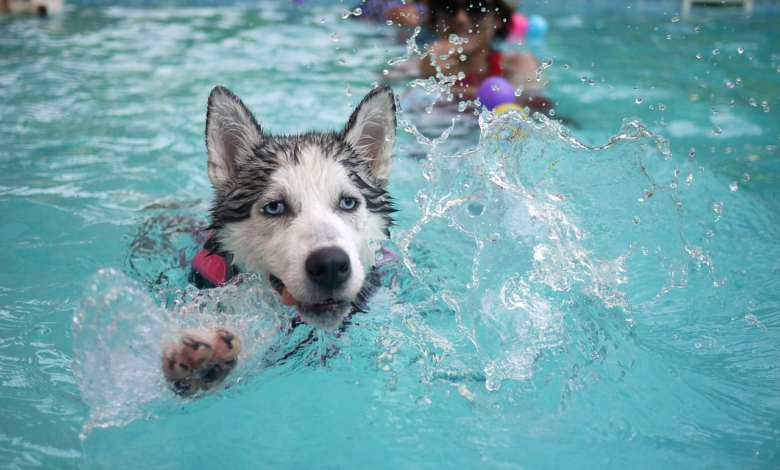
5 Tips for Safe Swimming Practices With Your Pet
Ever thought of making a splash with your furry friend? Swimming practices can be a delightful and refreshing activity for both you and your pet. Not only does it help in cooling off during the summer, but it also offers numerous health benefits for your pet.
Read More: Keep Your Pet Ears Clean and Healthy: Complete Guide
Tips for Safe Swimming Practices With Your Pet
Swimming practices is an excellent activity for pets, especially dogs. It’s fun, cooling during the summers, and can be a great bonding experience for you both. But as with everything, precautions are essential.
The joys of Swimming Practices with pets

Imagine the sunlight reflecting off the clear blue water, the gentle ripples, and your pet frolicking around, making playful splashes. It’s a picture-perfect moment, isn’t it? Swimming practices strengthen the bond you share with your pet, offer them an exciting form of exercise, and provide an opportunity for them to socialize with other pets.
Why do safe practices matter?
But just like teaching a child to swim, ensuring your pet’s safety is paramount. It’s not just about the fun; it’s about ensuring they are safe, secure, and enjoying themselves without any risks. The water can pose dangers, especially for pets unfamiliar with swimming practices.
Picking the Right Location
Location, location, location! It’s essential to choose a safe and appropriate place for your pet’s aquatic adventures.
Benefits of natural water bodies
Natural water bodies like lakes or calm beaches can provide a more authentic swimming practice experience. The calm waves, the vast expanse, and the soft sand can be exhilarating. However, always check for the safety of these places, ensuring no strong currents or hidden hazards.
Choosing safe man-made pools
Alternatively, specially designed dog pools or your backyard pool can serve the purpose. Ensure they have gradual steps for easy entry and exit, and are free from strong chemicals that might irritate your pet’s skin.
Preparing Your Pet
Every pet is unique. Some might be natural swimmers, while others might be apprehensive. It’s essential to understand and prepare them accordingly.
Acclimatization techniques
Start slow. Introduce your pet to shallow waters and let them get used to it. Use toys or treats to lure them in, and always ensure they feel secure. Remember, patience is key!
Health checks and vaccination
Before diving in, ensure your pet is in good health and has had all its vaccinations. This is especially crucial if you’re visiting public places where the chances of infections are high.
Safety Equipment
Just like humans, pets need their safety gear too.
Life vests and floatation devices
Even if your pet is a good swimmer, having them wear a life vest can be a lifesaver. It ensures pet buoyancy and makes it easier for them to float.
Safety barriers and alarms
If you have a pool at home, setting up barriers or alarms can prevent your pet from jumping in unsupervised. It’s always better to be safe than sorry!
Supervision and Training

Never leave your pet unsupervised while they swim. It’s as simple as that.
The role of an attentive owner
By being around, not only do you ensure their safety, but you also help them build confidence. Always stay alert for signs of distress or fatigue.
Training commands and techniques
Teaching commands like “stay”, “come”, or “stop” can be beneficial during swimming sessions. It allows you to have better control and ensures your pet’s safety.
Post-swim Care
After all the fun and frolic, post-swim care is essential.
Cleaning and drying
Ensure you rinse your pet to remove chlorine, salt, or any other contaminants. Dry them thoroughly, especially in areas prone to infections, like the ears.
Checking for injuries
A quick check can help in spotting any cuts, bruises, or infections, ensuring your pet remains in perfect health.
Read More: The Benefits of Regular Exercise for Pets
FAQs
- How can I introduce my pet to swimming practices? Start with shallow waters and use treats or toys as incentives. Patience is essential.
- Is it safe for all pets to swim? Not all pets are natural swimmers. Consult with a vet and ensure your pet is physically fit for swimming.
- How often should I take my pet swimming practices? It depends on your pet’s love for water and physical health. However, moderation is key to preventing exhaustion.
- Can my pet swim in chlorinated pools? Yes, but always rinse them off after to remove any chlorine and prevent skin irritations.
- What if my pet drinks the pool water? Occasional sips are fine, but ensure they have access to fresh drinking water to prevent them from drinking chlorinated or salty water.
Conclusion
Swimming practices with your pet can be an unforgettable experience filled with joy and laughter. By following these tips, you not only ensure their safety but also deepen the bond you share. Dive in and make a splash, but always keep safety first!







